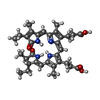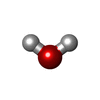[English] 日本語
 Yorodumi
Yorodumi- PDB-9i1r: Structure of the bicylindrical allophycocyanin core expressed dur... -
+ Open data
Open data
- Basic information
Basic information
| Entry | Database: PDB / ID: 9i1r | |||||||||||||||||||||
|---|---|---|---|---|---|---|---|---|---|---|---|---|---|---|---|---|---|---|---|---|---|---|
| Title | Structure of the bicylindrical allophycocyanin core expressed during far-red light photoacclimation (FaRLiP) | |||||||||||||||||||||
 Components Components |
| |||||||||||||||||||||
 Keywords Keywords | PHOTOSYNTHESIS / Phycobilisome / Allophycocyanin / Complex | |||||||||||||||||||||
| Function / homology |  Function and homology information Function and homology informationphycobilisome / plasma membrane-derived thylakoid membrane / photosynthesis / lyase activity Similarity search - Function | |||||||||||||||||||||
| Biological species |  Chroococcidiopsis thermalis PCC 7203 (bacteria) Chroococcidiopsis thermalis PCC 7203 (bacteria) | |||||||||||||||||||||
| Method | ELECTRON MICROSCOPY / single particle reconstruction / cryo EM / Resolution: 2.51 Å | |||||||||||||||||||||
 Authors Authors | Consoli, G. / Leong, H.F. / Davis, G.A. / Richardson, T. / McInnes, A. / Murray, J.W. / Fantuzzi, A. / Rutherford, A.W. | |||||||||||||||||||||
| Funding support | European Union,  United Kingdom, 6items United Kingdom, 6items
| |||||||||||||||||||||
 Citation Citation |  Journal: Commun Biol / Year: 2025 Journal: Commun Biol / Year: 2025Title: Structure of a stripped-down and tuned-up far-red phycobilisome. Authors: Giovanni Consoli / Ho Fong Leong / Geoffry A Davis / Tom Richardson / Aiysha McInnes / James W Murray / Andrea Fantuzzi / A William Rutherford /   Abstract: A diverse subset of cyanobacteria can transiently modify their photosynthetic machinery during far-red light photoacclimation to drive photosynthesis with less energetic photons (700 nm-800 nm). ...A diverse subset of cyanobacteria can transiently modify their photosynthetic machinery during far-red light photoacclimation to drive photosynthesis with less energetic photons (700 nm-800 nm). To achieve this, all the main light-driven components of the photosynthetic apparatus, including their allophycocyanin antenna, are replaced with red-shifted paralogues. Recent studies based on the structure of an incomplete complex provided some insights into the tuning of the far-red phycobiliproteins. Here, we solved the structure of the intact bicylindrical allophycocyanin complex from the cyanobacterium Chroococcidiopsis thermalis PCC 7203 at a resolution of 2.51 Å determined by Cryo-electron microscopy single particle analysis. A comparison between conserved structural features in far-red and white light allophycocyanin cores provides insight on the evolutionary adaptations needed to optimize excitation energy transfer in the far-red light adapted photosynthetic apparatus. The reduction in antenna size in far-red photosynthesis suggests a need to optimize membrane packing to increase the number of photosystems and tune the ratio between chlorophyll f molecules and bilin pigments, while the wider spread in the absorption range of the bilins suggests faster and more efficient excitation energy transfer to far-red Photosystem II by limiting backflow of excitation from the reaction centres to the far-red bilin pigments. | |||||||||||||||||||||
| History |
|
- Structure visualization
Structure visualization
| Structure viewer | Molecule:  Molmil Molmil Jmol/JSmol Jmol/JSmol |
|---|
- Downloads & links
Downloads & links
- Download
Download
| PDBx/mmCIF format |  9i1r.cif.gz 9i1r.cif.gz | 1.6 MB | Display |  PDBx/mmCIF format PDBx/mmCIF format |
|---|---|---|---|---|
| PDB format |  pdb9i1r.ent.gz pdb9i1r.ent.gz | 1.4 MB | Display |  PDB format PDB format |
| PDBx/mmJSON format |  9i1r.json.gz 9i1r.json.gz | Tree view |  PDBx/mmJSON format PDBx/mmJSON format | |
| Others |  Other downloads Other downloads |
-Validation report
| Summary document |  9i1r_validation.pdf.gz 9i1r_validation.pdf.gz | 4.8 MB | Display |  wwPDB validaton report wwPDB validaton report |
|---|---|---|---|---|
| Full document |  9i1r_full_validation.pdf.gz 9i1r_full_validation.pdf.gz | 5 MB | Display | |
| Data in XML |  9i1r_validation.xml.gz 9i1r_validation.xml.gz | 245.4 KB | Display | |
| Data in CIF |  9i1r_validation.cif.gz 9i1r_validation.cif.gz | 357.2 KB | Display | |
| Arichive directory |  https://data.pdbj.org/pub/pdb/validation_reports/i1/9i1r https://data.pdbj.org/pub/pdb/validation_reports/i1/9i1r ftp://data.pdbj.org/pub/pdb/validation_reports/i1/9i1r ftp://data.pdbj.org/pub/pdb/validation_reports/i1/9i1r | HTTPS FTP |
-Related structure data
| Related structure data |  52573MC M: map data used to model this data C: citing same article ( |
|---|---|
| Similar structure data | Similarity search - Function & homology  F&H Search F&H Search |
- Links
Links
- Assembly
Assembly
| Deposited unit | 
|
|---|---|
| 1 |
|
- Components
Components
-Protein , 5 types, 26 molecules AEGMOQTVXaegmoqtvxCcIiKkSs
| #1: Protein | Mass: 18117.572 Da / Num. of mol.: 18 Source method: isolated from a genetically manipulated source Source: (gene. exp.)  Chroococcidiopsis thermalis PCC 7203 (bacteria) Chroococcidiopsis thermalis PCC 7203 (bacteria)Gene: Chro_1032 Production host:  Chroococcidiopsis thermalis PCC 7203 (bacteria) Chroococcidiopsis thermalis PCC 7203 (bacteria)References: UniProt: K9TX42 #3: Protein | Mass: 19978.068 Da / Num. of mol.: 2 Source method: isolated from a genetically manipulated source Source: (gene. exp.)  Chroococcidiopsis thermalis PCC 7203 (bacteria) Chroococcidiopsis thermalis PCC 7203 (bacteria)Gene: Chro_1036 Production host:  Chroococcidiopsis thermalis PCC 7203 (bacteria) Chroococcidiopsis thermalis PCC 7203 (bacteria)References: UniProt: K9TVZ1 #4: Protein | Mass: 18260.959 Da / Num. of mol.: 2 Source method: isolated from a genetically manipulated source Source: (gene. exp.)  Chroococcidiopsis thermalis PCC 7203 (bacteria) Chroococcidiopsis thermalis PCC 7203 (bacteria)Gene: Chro_1034 Production host:  Chroococcidiopsis thermalis PCC 7203 (bacteria) Chroococcidiopsis thermalis PCC 7203 (bacteria)References: UniProt: K9TWK3 #6: Protein | Mass: 88103.438 Da / Num. of mol.: 2 Source method: isolated from a genetically manipulated source Source: (gene. exp.)  Chroococcidiopsis thermalis PCC 7203 (bacteria) Chroococcidiopsis thermalis PCC 7203 (bacteria)Gene: Chro_1035 Production host:  Chroococcidiopsis thermalis PCC 7203 (bacteria) Chroococcidiopsis thermalis PCC 7203 (bacteria)References: UniProt: K9TUP3 #7: Protein | Mass: 7848.333 Da / Num. of mol.: 2 Source method: isolated from a genetically manipulated source Source: (gene. exp.)  Chroococcidiopsis thermalis PCC 7203 (bacteria) Chroococcidiopsis thermalis PCC 7203 (bacteria)Gene: Chro_4322 Production host:  Chroococcidiopsis thermalis PCC 7203 (bacteria) Chroococcidiopsis thermalis PCC 7203 (bacteria)References: UniProt: K9U510 |
|---|
-Allophycocyanin ... , 2 types, 24 molecules BDFHLNPRUWYbdfhlnpruwyJj
| #2: Protein | Mass: 17495.893 Da / Num. of mol.: 22 Source method: isolated from a genetically manipulated source Source: (gene. exp.)  Chroococcidiopsis thermalis PCC 7203 (bacteria) Chroococcidiopsis thermalis PCC 7203 (bacteria)Gene: Chro_1033 Production host:  Chroococcidiopsis thermalis PCC 7203 (bacteria) Chroococcidiopsis thermalis PCC 7203 (bacteria)References: UniProt: K9TVG8 #5: Protein | Mass: 18777.422 Da / Num. of mol.: 2 Source method: isolated from a genetically manipulated source Source: (gene. exp.)  Chroococcidiopsis thermalis PCC 7203 (bacteria) Chroococcidiopsis thermalis PCC 7203 (bacteria)Gene: Chro_1766 Production host:  Chroococcidiopsis thermalis PCC 7203 (bacteria) Chroococcidiopsis thermalis PCC 7203 (bacteria)References: UniProt: K9TY40 |
|---|
-Non-polymers , 2 types, 68 molecules 


| #8: Chemical | ChemComp-CYC / #9: Water | ChemComp-HOH / | |
|---|
-Details
| Has ligand of interest | Y |
|---|---|
| Has protein modification | Y |
-Experimental details
-Experiment
| Experiment | Method: ELECTRON MICROSCOPY |
|---|---|
| EM experiment | Aggregation state: PARTICLE / 3D reconstruction method: single particle reconstruction |
- Sample preparation
Sample preparation
| Component | Name: Bicylindrical far-red light adapted allophycocyanin complex Type: COMPLEX / Entity ID: #1-#7 / Source: NATURAL | ||||||||||||||||||||||||
|---|---|---|---|---|---|---|---|---|---|---|---|---|---|---|---|---|---|---|---|---|---|---|---|---|---|
| Molecular weight | Experimental value: NO | ||||||||||||||||||||||||
| Source (natural) | Organism:  Chroococcidiopsis thermalis (bacteria) Chroococcidiopsis thermalis (bacteria) | ||||||||||||||||||||||||
| Buffer solution | pH: 6.5 | ||||||||||||||||||||||||
| Buffer component |
| ||||||||||||||||||||||||
| Specimen | Conc.: 1 mg/ml / Embedding applied: NO / Shadowing applied: NO / Staining applied: NO / Vitrification applied: YES / Details: the sample was monodisperse | ||||||||||||||||||||||||
| Specimen support | Grid material: GOLD / Grid mesh size: 300 divisions/in. / Grid type: Quantifoil R2/1 | ||||||||||||||||||||||||
| Vitrification | Instrument: FEI VITROBOT MARK IV / Cryogen name: ETHANE / Humidity: 95 % / Chamber temperature: 277 K |
- Electron microscopy imaging
Electron microscopy imaging
| Experimental equipment |  Model: Titan Krios / Image courtesy: FEI Company |
|---|---|
| Microscopy | Model: TFS KRIOS |
| Electron gun | Electron source:  FIELD EMISSION GUN / Accelerating voltage: 300 kV / Illumination mode: FLOOD BEAM FIELD EMISSION GUN / Accelerating voltage: 300 kV / Illumination mode: FLOOD BEAM |
| Electron lens | Mode: DIFFRACTION / Nominal defocus max: 2400 nm / Nominal defocus min: 600 nm |
| Specimen holder | Cryogen: NITROGEN / Specimen holder model: FEI TITAN KRIOS AUTOGRID HOLDER |
| Image recording | Electron dose: 40 e/Å2 / Film or detector model: FEI FALCON IV (4k x 4k) / Num. of grids imaged: 1 / Num. of real images: 9397 |
| Image scans | Width: 4096 / Height: 4096 |
- Processing
Processing
| EM software |
| ||||||||||||||||||||||||
|---|---|---|---|---|---|---|---|---|---|---|---|---|---|---|---|---|---|---|---|---|---|---|---|---|---|
| CTF correction | Type: PHASE FLIPPING AND AMPLITUDE CORRECTION | ||||||||||||||||||||||||
| Symmetry | Point symmetry: C2 (2 fold cyclic) | ||||||||||||||||||||||||
| 3D reconstruction | Resolution: 2.51 Å / Resolution method: FSC 0.143 CUT-OFF / Num. of particles: 36300 / Symmetry type: POINT | ||||||||||||||||||||||||
| Atomic model building | Protocol: RIGID BODY FIT | ||||||||||||||||||||||||
| Atomic model building | PDB-ID: 8UHE Accession code: 8UHE / Source name: PDB / Type: experimental model | ||||||||||||||||||||||||
| Refinement | Highest resolution: 2.51 Å Stereochemistry target values: REAL-SPACE (WEIGHTED MAP SUM AT ATOM CENTERS) | ||||||||||||||||||||||||
| Refine LS restraints |
|
 Movie
Movie Controller
Controller


 PDBj
PDBj

